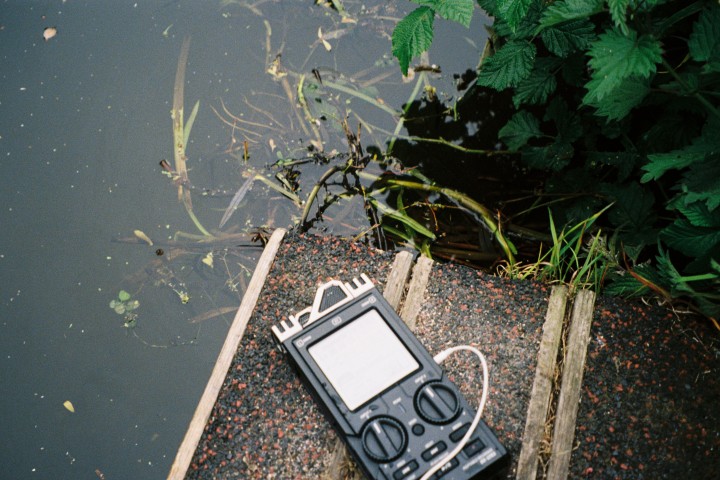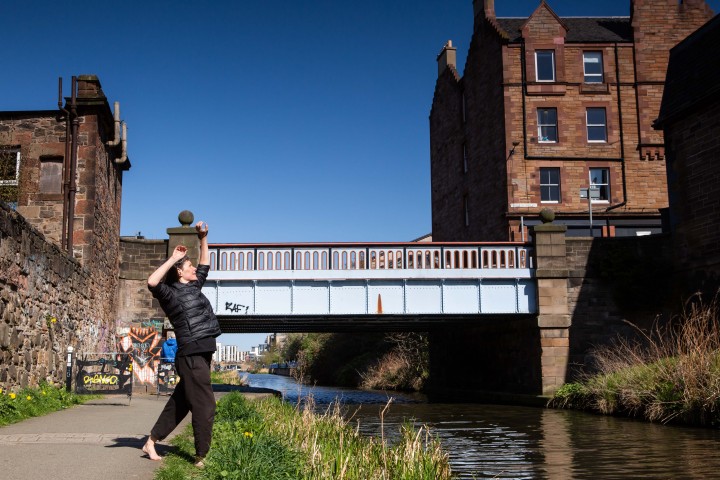Scottish Art News
Latest news
Magazine
News & Press
Publications
Channels
By Neil Cooper, 25.07.2022

Edinburgh Art Festival’s Associate Artist Emmie McLuskey discusses newly commissioned public works inspired by and in response to the Edinburgh and Glasgow Union Canal on its 200th anniversary year with writer Neil Cooper.
Things have come a long way for the Edinburgh and Glasgow Union Canal since it first opened for business in 1822. This should be apparent when Edinburgh Art Festival presents Channels, a series of new public works by four artists, curated by this year’s EAF Associate Artist, Emmie McLuskey, as part of the festival’s 2022 commissions programme.
From Lochrin Basin to Wester Hailes, works by Maeve Redmond, Hannan Jones, Amanda Thomson and Janice Parker navigate their way through the waterway’s rich flow of history by way of sign writing, sound, botany, writing, and dance.
“The canal kind of sits outside of the main bit of the city, and it's got a really interesting history in relation to industry,” says McLuskey, EAF’s second Associate Artist following on from Tako Taal in 2021. “This is obviously a huge generalisation, but Edinburgh doesn't necessarily see itself as an industrial city.”
McLuskey was attracted to Channels by way of another project she was working on that raised questions about environments, social justice issues, gentrification and change. “There were a lot of conversations about home, how to listen to environment, and how to work with contexts that we're a part of, rather than being against them, or trying to put something into a context that hasn't listened to what's actually going on.”
 Janice Parker, research image for Edinburgh Art Festival 2022. Credit: Sally Jubb Photography.
Janice Parker, research image for Edinburgh Art Festival 2022. Credit: Sally Jubb Photography.
The Union Canal was originally built to carry coal and other minerals before being made redundant within twenty years by the rise of the railways. Its 200th anniversary The Wave of Translation programme shows off its regeneration as a leisure-based attraction that runs alongside a similarly rebuilt Edinburgh.
“I saw a lot of overlaps with the cycles of industry that were playing out in terms of this particular canal,” McLuskey says. “At Lochrin Basin, there are a lot of developments happening around Haymarket, with student accommodation and hotels being built, and it is definitely in a state of flux.
“As you progress along the canal, you move through different communities, and you see lots of change happening. What is now a space for leisure was once an economic device to improve trade between Glasgow and Edinburgh and further afield, and that brought up loads of conversations around industry, capitalism and migration. That’s interesting to deal with in the context of a festival, specifically in Edinburgh, because of many important conversations to be had around festival culture here.”
Rather than the artists addressing these issues explicitly, for McLuskey, “it was more interesting they deal with these conversations as different ways of listening, and as different ways of really engaging with context. For me, that is political, because it's responding to what's already happening, and what's already there, rather than trying to add more and more growth. What is the history that already existed, how do we listen to that, and how as artists do we engage with that?”
.jpg) Amanda Thomson, A Scots Dictionary of Nature, 2019. Image courtesy of the artist.
Amanda Thomson, A Scots Dictionary of Nature, 2019. Image courtesy of the artist.
The four Channels artists have answered in different ways. Maeve Redmond’s ‘The Mathematical River’ (2022) sees her working with sign writer Tatch Hatch-Robertson to create two sign paintings using traditional techniques. Hannan Jones’ ‘Surface bounce and cycles’ (2022) is a series of sound works using recordings made both underwater and above ground.
For ‘Mainly in Sinuousities’ (2022) Amanda Thomson worked with botanist Greg Kenicer to produce a printed publication that offers a guide to the flowers and plants growing around the canal with historical commentary. Five plaques will be placed at different points of interest along the canal.
‘Not Brittle, Not Rigid, Not Fixed’ (2022) sees dancer and choreographer Janice Parker create a new set of solo performances each day in response to the sights and smells of the canal, as well as any chance meetings she has with passers-by in an exploration of our relationship with public space.
As well as the commissions, McLuskey will host Background Noise, a rolling programme of radio broadcasts that will look at some of the concerns raised by Channels through conversations and interviews.
EAF also hosts ‘Watch this Space’, an initiative led by Dutch artist Jeanne van Heeswijk’s Community Wellbeing Collective (C.W.C.) working with a group of Wester Hailes residents. Montreal based First Nations artist Nadia Myre, meanwhile, leads a multi-format programme titled ‘Tell Me of Your Boats and Your Waters - Where Do They Come From. Where Do They Go’.
“My main focus with the programme,” McLuskey says, “is that we engage and learn together about the context of the canal, and that the programme is for people that go to the canal. Not that I want to ignore a festival audience, but I think the four artists we’ve commissioned can engage in a really meaningful way that will have longevity beyond the festival period. A lot of the processes happening as part of the festival are the start of the work rather than the end of it.
“My hope for Channels is that it continues a conversation for people, and allows them a different sort of lens to look at something in Edinburgh’s history that is maybe not talked about so much, when it actually was a very industrial city. I hope it opens up conversations about what we're a part of now, and how we want to engage with these things as we move towards the future.”
Channels runs as part of Edinburgh Art Festival, Saturday July 28th–Sunday August 28th. Background Noise can be heard in August here.




